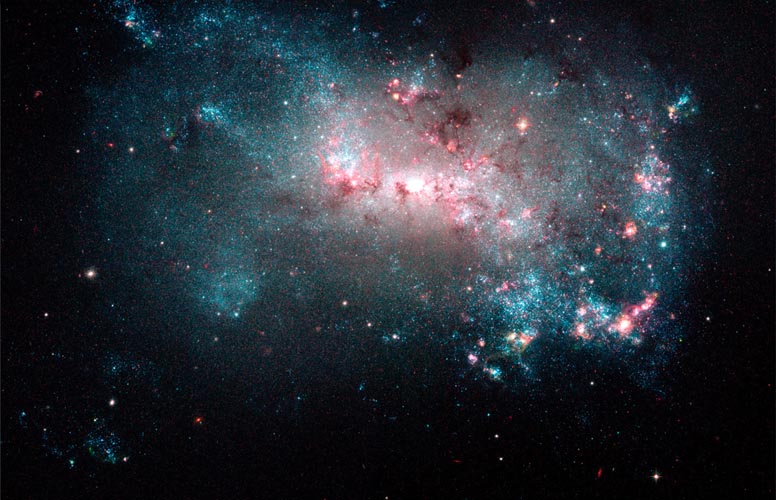
Magellanic dwarf irregular galaxy
R.A. 12h 28m 10s.96 Dec. +44° 05' 33".4
Canes Venatici
Approximately 13 million light-years (4 Mpc) away.
10.0
6.2 by 4.4 arcmin (20,000 light-years across
This image is 5 arcminutes (19,000 light-years or 6 Kpc) wide.
ACS/WFC
November 2005
5.3 hours
NASA, ESA, A. Aloisi (STScI/ESA), and The Hubble Heritage (STScI/AURA)-ESA/Hubble Collaboration
July 3, 2007
ABOUT THIS IMAGE:
On July 4, fireworks blaze over the skies of American cities in the annual Independence Day celebrations.
But nearly 12.5 million light-years away in the dwarf galaxy NGC 4449 stellar "fireworks" are going off all the time.
Hundreds of thousands of vibrant blue and red stars blaze in this image taken by NASA's Hubble Space Telescope. Hot bluish-white clusters of massive stars are scattered throughout the galaxy, interspersed with numerous dustier, reddish regions of current star formation. Massive dark clouds of gas and dust are silhouetted against the starlight.
NGC 4449 has been forming stars for several billion years, but currently it is experiencing a star formation event at a much higher rate than in the past. This unusually explosive and intense star formation activity qualifies as a starburst. At the current rate, the gas supply that feeds the stellar production would only last for another billion years or so.
Starbursts usually occur in the central regions of galaxies, but NGC 4449 has more widespread star formation activity, since the very youngest stars are observed both in the nucleus and in streams surrounding the galaxy.
A "global" starburst like NGC 4449 resembles primordial star forming galaxies, which grew by merging with and accreting smaller stellar systems. Since NGC 4449 is close enough to be observed in great detail, it is the ideal laboratory for the investigation of what may have occurred during galactic formation and evolution in the early universe.
It's likely that the current widespread starburst was triggered by interaction or merging with a smaller companion. NGC 4449 belongs to a group of galaxies in the constellation Canes Venatici. Astronomers think that NGC 4449's star formation has been influenced by interactions with several of its neighbors.
This
image was taken in November 2005 by an international science team led
by Alessandra Aloisi of the Space Telescope Science Institute (STScI)
in Baltimore and the European Space Agency (ESA). Other team members include
Francesca Annibali (STScI), Claus Leitherer (STScI), Jennifer Mack (STScI),
Marco Sirianni (STScI/ESA), Monica Tosi (INAF-OAB), and Roeland van der
Marel (STScI).
From Wikipedia:
NGC 4449 is an irregular Magellanic type galaxy in the constellation Canes
Venatici, located about 12 million light-years away. It is part of the
M94 Group or Canes Venatici I Group that is relatively close to the Local
Group hosting our Milky Way galaxy. It was first discovered by William
Herschel on April 27, 1788
This galaxy is similar in nature to the Milky Way's satellite
galaxy, the Large Magellanic Cloud (LMC),though is not as bright nor as large. NGC 4449 has a general
bar shape, also characteristic of the LMC, with scattered young blue star clusters. Unlike the Large
Magellanic Cloud, however, NGC 4449 is considered a starburst galaxy due to its high rate of star formation
(twice the one of the LMC) and includes several massive and young star clusters, one of them in the galaxy's
center. Photos of the galaxy show the pinkish glow of atomic hydrogen gas, the telltale tracer of massive
star forming regions.
NGC 4449 is surrounded by a large envelope of neutral
hydrogen that extends over an area of 75 arc minutes (14 times larger than the optical diameter of the galaxy).
The envelope shows distortions and irregularities likely caused by interactions with nearby galaxies. Interactions
with nearby galaxies are thought to have influenced star formation in NGC 4449 and, in fact, in 2012 two small
galaxies have been discovered interacting with this galaxy: a very low surface brightness disrupted dwarf
spheroidal with the same stellar mass as NGC 4449's halo but with a ratio of dark matter to stellar matter
between 5 and 10 times that of NGC 4449 and a highly flattened globular cluster with two tails of young
stars that may be the nucleus of a gas-rich galaxy. Both satellites have apparently been disrupted by NGC
4449 and are now being absorbed by it.